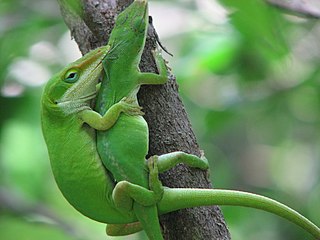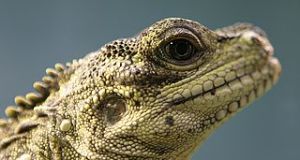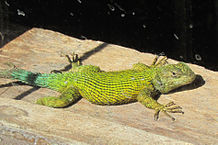With proper care, the Green or Carolina Anole, Anolis carolinensis, is quite willing to breed in captivity. However, being relatively inexpensive, it is often considered a “beginner’s pet” and not worthy of serious attention. This is a serious mistake, as anoles of all species are among the most interesting of all lizards. In fact, the antics of a colony of Green Anoles that I exhibited at the Bronx Zoo regularly stole attention from the more “dramatic” but sedentary Water Moccasins that shared their quarters. What’s more, we still have much to learn regarding Green Anole reproduction…hatchlings can be difficult to rear, and second-generation breeding is rare. There’s plenty to challenge the well-experienced keeper, and information gathered will likely be applicable to rare and less-studied relatives. You can read about how to breed Green Anoles, Brown Anoles, Bark Anoles and many others below. However, over 350 anole species have been described, and details vary. Please post below for specific information on other anoles.
Getting Started
A proper habitat and well-nourished, healthy animals are essential for breeding success. When conditions are not ideal, reptiles respond by eliminating non-essential activities such as breeding. Green Anoles kept in bare, cramped terrariums and fed upon crickets and mealworms alone will not breed. Please see this four-part article on Green Anole Care and Natural History for further information, and be sure to post any your questions below.
Natural Breeding Behavior
The Green Anole’s breeding season extends from April to September. Males display with vigorous head-bobs and flared dewlaps. The dewlap reflects ultraviolet light and is perceived by the female as more brilliant than the red coloration that we see.
Males actively pursue females and, using their mouths, grasp them by the neck during copulation. Please see the articles linked below for notes on distinguishing the sexes. One or two eggs are deposited 2-4 weeks after mating occurs. Most females leave them on or just below the substrate, along a log or other structure, although some bury eggs in soil or secrete them below leaf litter. Many individuals will deposit eggs above-ground if possible. Hanging live plants surrounded by a substrate of sphagnum moss and coconut husk make ideal sites. The “pool areas” incorporated into Hagen Smart Plants (intended as a deposition site for Poison Frog eggs) might be attractive to gravid anoles if filled with damp moss; I hope to try this out shortly.
Inducing Reproduction
Females seem able to retain sperm, but most mate several times each season. Additional clutches are produced at varying intervals, to a total of 8-10 eggs per female.
Breeding may occur spontaneously, but will be more likely if your anoles are subjected to cyclic changes in temperature, light and humidity levels that mimic natural seasonal variations. The Green Anole’s huge range extends from Oklahoma and South Carolina through Florida to Cuba and other Caribbean islands. A 6-8 week “winter” featuring reductions in temperature, humidity, and day-length is very effective in bringing them into breeding condition. Populations in the northern portions of the range experience longer and cooler winters than do those from the south. Most pet trade animals, however, are collected in central/south Florida and Louisiana.
Anoles do not require true hibernation or brumation. During the cooling off period, daytime temperatures can be kept at 81-83 F, with a warmer basking site available. At night, temperatures should be allowed to dip to 62-68 F (60-65 F if your anoles originated in the northern portion of the range). The daytime light cycle should gradually be reduced to 8 -10 hours. Mist once daily, but be sure that the anoles are drinking regularly. Lowering the humidity is not as critical as daylight and temperature reductions.
After 6-8 weeks, gradually increase day length, temperature, and humidity. Providing a wide variety of novel food items is a time-honored way of inducing reproduction in a wide variety of species. Try offering small roaches, silkworms, and wild-caught caterpillars, leaf hoppers, moths, beetles, earwigs and other invertebrates. Reptile misters and foggers can be used to dramatically increase humidity levels as the breeding season arrives. Please see these articles for further information on collecting insects.
Incubating the Eggs
Eggs may be incubated in vermiculite or moist sphagnum moss. I prefer to use a vermiculite and water in a 1:1 ratio by weight (please see this article for details on setting this up), but success has been had by adding just enough water so that the substrate barely holds together when squeezed.
The incubation container (a plastic deli cup will do) is best kept in a small commercial reptile incubator at 82-88 F. However, eggs may also be kept at room temperature in an appropriately-warm attic or similar location. Depending upon temperature and humidity, the eggs will hatch in 30-50 days. Please post below for detailed information on incubation.
Rearing the Young
Hatchling Green Anoles frustrate many hobbyists. They are aggressive towards smaller cage-mates, prone to desiccation, and need ample exposure to UVB. But in my experience, most failures are due to nutritional deficiencies. They will not thrive on pinheads and fruit flies alone.
Providing dietary variety can be difficult, given their size, but there are many options. “Meadow plankton”, leaf litter invertebrates, tiny moths, termites, sap beetles, flour beetle grubs and other small invertebrates are essential. Insect traps such as the Zoo Med Bug Napper will assist in the collection of tiny moths and other flying insects. The information in this article on Feeding Poison Frogs is largely applicable. Please also post your questions below.
Further Reading
Important Supplies for Green Anoles and Other Lizards
 That Reptile Blog – Reptile, Amphibian and Exotic Pet Care and Information
That Reptile Blog – Reptile, Amphibian and Exotic Pet Care and Information







very interesting, thanks for sharing, I would have thought they would lay more eggs than that
My pleasure, thanks. I’ve never seen more than 2 at a time, but well-nourished females can produce 8-10 over several months, perhaps even a few more than that. Best, frank
Hi Frank,
Ive read the articles in your blog for some time now and I allways find them quite interesting. I have been into reptiles and amphibians for 20 years now and kept and bred many species of mainly turtles and lizards. I have yet to keep a snake of my own (but help friends all the time with theirs and also reabilitated a wild one once). Untill a year ago I also kept and bred green anoles, including some F2s of mine. Had to stop and find new homes for all, because I was very tyerd of the work it required. Would like to share with you a few thoughs.
I only got regular descendece from my females when I housed them in a large outdoor terraria. Here in South Portugal the climate is near perfect, you have however to take them in late october and water regularily and provide enough shade during spring and summer. I had WONDERFULL TAME females which learned a owesame trick I never herd anyone reporting. Many times I ran out of small enough dubias to feed them (I allways follow to rule of only ofering them food half the size of their heads). What they learned was to actually take insects cut in chunks! I selected largish dubia nimphs (to large for them to eat normaly) and would cut them in half or in 4. The insect chunks were put in a plate inside de enclosure and the anoles would come and stuff themselfes on the dubias.
The babies can be a REAL pain to raise for a inexperienced keeper. I had sucess with more then one way. I actually had babys that survived inside the adult enclosure only to be found later already with some good size on them. I generally however removed the eggs and incubated them (which for me just means putting them in a small conteiner with the correct humity and into a warm room). The babys can be very hard to induce a feeding responce. My best metod (which requires a very steady hand and ALLOT OF PATIENCE) consisted in actually hand feeding them. I simply allowed the baby lizard to crawl into my hand and very carefully with a pair of twezers, I rubbed something like a dismenbered baby dubia on the baby mouth and/ or lips. If you get them to start liking you got it. I also housed them individually in a very simple container with soft paper for substrate and gave them daily sun baths of a few minutes several times a day. The babys raised this way were very calm and had a “semi-agreeable” disposition if you aproached them gently. I eventually plan on going back to them but only in a greenhouse tipe of enclosure were they can have some sort of independence… or I will move to Florida =)
Cheers
Hello Pedro,
Thanks so much for the interesting observations…glad to hear of your interest in green anoles…they get minimal attention here, except as “short-term” pets.
Portugal would seem ideal; best results here in the USA are had by folks living in the south, housing them outdoors for much of the year; greenhouses in NYC worked well for me also.
As you suggest, their taking dead insects is extra-ordinary; thank you! They take nectar sometimes, so there may be a scent component to their feeding response, but I never made the connection to insects. I applaud your patience…rubbing the hatchlings’ snouts ids a great idea…this sometimes works for snakes, and even tarantulas, but again I’ve not run macros similar reports for anoles.
Please keep me posted on this and your other species..interesting for readers here to learn about techniques used in Europe, and interests. let me know if you need links to other articles in which you may be interested., Best, Frank
Hi Frank,
Here it is relatively easy to get hold of cb green anoles, if you know a breeder. There are allot of anole breeders in Europe, most however focus on much rarer and expensive species, say Anolis allisoni. However the herpetocultural culture of Portugal is one by itself and diferent from other European countries. It is a fairly recent interest for the masses and so more standart species like bearded dragons, iguanas and sliders constitute like 80% of what you see.
I would say there is a motion thing still for them to accept and also the familiarity, I allways fed them in the same place. My tecnike consists in first crushing the dubia head and midsection to teoricly despose of it in a humane way. Then with a pair of scissors I cut the dubia in half or in 4. There are still a copple of legs moving all the time… take it or leave it =) have to feed me lizards… It is amazing the amount of food a adult can take down if it is allowed to do so.
I would say they are great pets if your looking for a purely display lizard you can also put in a planted greenhouse in a temperate climate, the green colour they get at sun ligth is hard to beat…for me at least.
Cheers
Thanks very much Pedro…very useful info . The movement is nerves firing, people sometimes get thrown off by this but insect is not feeling anything. They do eat quite a bit, more in relation to size than many other lizards; I think this is often overlooked by keepers..same re the color, as you say – when kept properly, they are spectacular. please keep me posted, best, Frank
My baby anole just hatched yesterday and Im confused on how to water it and feed it. Thank you
For a newly hatched anole you would want to feed very small insects. Pinhead crickets or flightless fruit flies would probably be your best option. As far as water goes, just make sure that you mist down the enclosure very well about twice a day. The anole will drink from the droplets on the sides of the enclosure and plants. I hope that helps!
I have a female who laid her egg on a plant leaf in her cage. Is it ok, or should I move it to the medium below?